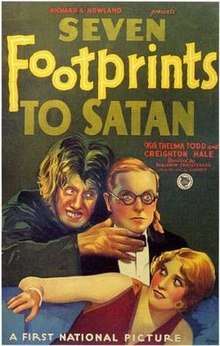Seven Footprints to Satan
Seven Footprints to Satan is a 1929 American film directed by Danish filmmaker Benjamin Christensen. Based on the 1928 story of the same name by Abraham Merritt, it stars Thelma Todd, Creighton Hale, William V. Mong and Sheldon Lewis. It was first released as a silent film and later as a part-talkie.[2][4][5]
| Seven Footprints to Satan | |
|---|---|
 | |
| Directed by | Benjamin Christensen |
| Produced by | Wid Gunning |
| Screenplay by | Benjamin Christensen[1] |
| Story by | Benjamin Christensen[1] |
| Based on | 7 Footprints to Satan by Abraham Merritt |
| Starring | |
| Cinematography | Sol Polito[1] |
| Edited by | Frank Ware[1] |
Production company | First National Pictures, Inc.[1] |
| Distributed by | First National Pictures, Inc.[2] |
Release date |
|
| Country | United States[2] |
| Box office | $129,950[3] |
Plot
Jim and Eve, a young society couple, are kidnapped on the eve of Jim's departure for Africa and brought to a mansion that is home to a strange and glamorous Satanic cult. Jim is put through a number of strange adventures in the old house and tries to maintain his courage. During the course of the film, Jim encounters an old witch, a dwarf, a gorilla and a strange shaggy creature called "The Spider" (played by Sheldon Lewis). In the end, he is confronted by Satan himself who puts him to a final test. It is revealed to be a hoax played on Jim and Eve by their friends to test their courage.
Cast
- Thelma Todd as Eve
- Creighton Hale as Jim
- Sheldon Lewis as "The Spider"
- William V. Mong as The Professor
- Laska Winter as Satan's Mistress
- DeWitt Jennings as Uncle Joe
- Nora Cecil as The Old Witch
- Kalla Pasha as Professor Von Viede
- Harry Tenbrook as Eve's chauffeur
- Cissy Fitzgerald as The Old Lady
- Angelo Rossitto as The Dwarf
Production
Seven Footprints to Satan was adapted from the 1928 novel 7 Footprints to Satan by Abraham Merritt.[1][2] The screenplay was written by director Benjamin Christensen under the name Richard Bee.[1][6] Initially overjoyed that his story would be adapted into a film, Merritt later spoke about the film in a 1933 interview, stating that he "sat through the picture and wept. The only similarity between the book and the picture was the title. The picture likewise killed the booksale [...] for people who saw the picture felt no impulse thereafter to read the book."[7][8]
Christensen cast actor Creighton Hale in the role of Jim in an attempt to capitalize on Hale's having starred in The Cat in the Canary, an earlier similar "old dark house" film.[6]
Release
The silent version of the film was released on 27 January 1929 while a version with sound was released on 17 February 1929.[5]
The original running time of Seven Footprints to Satan is in question. [9] In his book Thrills Untapped: Neglected Horror, Science Fiction and Fantasy Films, 1928-1936, Michael R. Pitts noted that most contemporary reviews stated the film had a 60 minute running time seemingly referring to the sound version of the film.[9] The silent release is listed at being 168 feet shorter than the sound release, with a restored silent version running at around 77 minutes.[9]
Pitts described the film as a "box office flop",[10] with a gross of $129,950.[3]
Critical response
Pitts described that contemporary critics were overall "not impressed" with Seven Footprints to Satan.[11] A review in Film Daily described the film as a "has of weird and wild doings in a mysterious house with a lot of phony thrills."[11] Movie Age opined that "Maybe we haven't seen all the so-called mystery-drama-thrillers so far released, but of those what we have seen, this Seven Footprints to Satan is one of the poorest. There is not a convincing situation in it, and the explanation of it all at the end takes the cake...no rhyme or reason."[11] A review in Variety similarly called the film "all hokum", noting "another of those fright producers, wholly baffling from start to finish. An utterly moronic sound film appearl to all the passions."[11] One reviewer in Photoplay stated that they loved the title of the film but found it "just a hodgepodge mystery story"[11]
A review in Harrison's Reports commented that "People will no doubt enjoy this picture provided they don't take it seriously. It is one of the wildest mystery trapdoor melodramas that has been produced in many a moon."[11]
References
- Pitts 2018, p. 235.
- "Seven Footprints to Satan". American Film Institute. Retrieved 13 January 2020.
- Donati, p. 35.
- Clarens, p. 57.
- Munden 1997, p. 698.
- Workman & Howarth 2016, p. 345.
- Soister, Nicolella & Joyce 2014, p. 508.
- Soister, Nicolella & Joyce 2014, p. 509.
- Pitts 2018, p. 239.
- Pitts 2018, p. 237.
- Pitts 2018, p. 238.
Footnotes
- Clarens, Carlos. An Illustrated History of Horror and Science-fiction Films. Putnam.CS1 maint: ref=harv (link)
- Donati, William. The Life and Death of Thelma Todd. Jefferson, NC: McFarland & Company.CS1 maint: ref=harv (link)
- Munden, Kenneth White (1997). The American Film Institute Catalog of Motion Pictures Produced in the United States, Part 1. University of California Press. ISBN 0520209699.CS1 maint: ref=harv (link)
- Soister, John T.; Nicolella, Henry; Joyce, Steve (2014). American Silent Horror, Science Fiction and Fantasy Feature Films, 1913-1929. McFarland. ISBN 0786487909.CS1 maint: ref=harv (link)
- Pitts, Michael R. (2018). Thrills Untapped: Neglected Horror, Science Fiction and Fantasy Films, 1928-1936. McFarland. ISBN 1476632898.CS1 maint: ref=harv (link)
- Workman, Christopher; Howarth, Troy (2016). Tome of Terror: Horror Films of the Silent Era. Midnight Marquee Press. ISBN 978-1936168-68-2.CS1 maint: ref=harv (link)